How Are Pearls Made?
'How are pearls made' is a mystery explained in the many Polynesian legends surrounding Tahitian black pearls.
Perhaps the glory of the heavens has come to rest on the ocean floor in the iridescent mother-of-pearl. Or has imagination created fantasy from a curious act of nature, and the black-lipped oyster simply protects it's delicate flesh by coating an intrusive grain of sand with aragonite, a form of calcium carbonate. These precious pearls are so valuable that man has intervened to simulate nature and have oysters making more. And specific criteria define what may be sold as cultured Tahitian pearls.
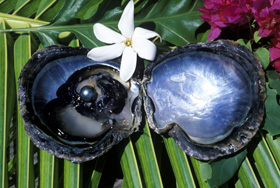 Tahiti Tourisme- Raymond Sahuquet
Tahiti Tourisme- Raymond SahuquetA Tahitian Pearl for Princess Bora Bora
Long ago...it is said...Ora, god of peace and fertility, came down to earth on a rainbow and gave a pearl from Te Ufi (the black-lipped oyster) to the beautiful Princess of Bora Bora to demonstrate his love for her.
It is also said...the moon bathes the ocean with it's light, to attract Te Ufi to the ocean surface, and infuse him with dew from the heavens. Time polishes this radiant drop of heavenly light and coats it with a glossy mantle of harmonious blue, green, pink and golden luster.
Tahiti Pearls are to Dive For
Tahitian black pearls became desirable commercially about 1870. At the Tuamoto lagoons, island divers (wearing only small goggles) were employed to descend to depths of 25- 30 meters to gather oysters. The main purpose was to collect shells for producing mother-of-pearl buttons. In the natural environment of Polynesian lagoons only 1 oyster out of 15,000 has a pearl. Oyster beds are slow growing, so by 1960 the oyster numbers had been depleted. Now, oysters are only gathered to supply Tahitian pearl farms.
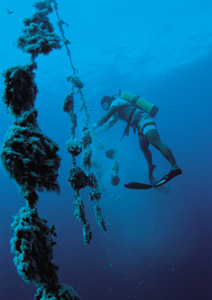 Tahiti Tourisme - Philipe Bacchet
Tahiti Tourisme - Philipe BacchetA Frenchman, Jean-Marie Dormand arranged (with the French Polynesian Government) to bring a Japanese pearl oyster technician to Tahiti. In 1963, as an experiment, the first Tahitian pearl farm was created in the Tuamotos at Hikueru Atoll. An atoll derives rich mineral salts from the depths of the cold waters, and the coral crown develops from photosynthesis in the tropical sun. This provides an ideal environment for the black-lipped oyster. In 1965, 1000 pearls were successfully harvested.
French Polynesia's 2nd Largest Industry
Due to the desire for beautiful Tahitian pearl jewelry, there are now thousands of people employed in hundreds of cooperative and private Tahitian pearl farms on 26 atolls. Many Polynesians who left after destructive hurricanes in 1983 have returned to work in the Tahiti pearl industry. Some family farms still produce pearls. About 85% of the industry is controlled by Robert Wan's Tahiti Perles and several other large private companies. This is because they utilize a vertical business model for farming, wholesaling and retailing. Find out where you can visit a pearl farm and shop for Tahitian pearl jewelry while in French Polynesia.
Effects of Tahitian Pearl Farms on Marine Life
Tahitian pearl farming has ecological benefits as it allows renewal of natural oyster stocks. It also acts as an impetus to preserve marine environments, as either sewerage, or run off from fertilizers used in agriculture would affect the oysters. But turtle survival has become an issue. Their favorite food is oysters. So wire fencing need to be coiled around the hanging strings of oysters to prevent turtles breaking open the shells and feasting on the pearl farmer's harvest. Some Tahitian Pearl farms find it easier to cull the turtles.
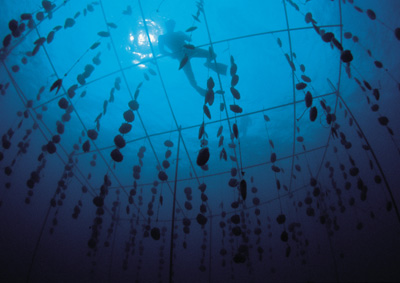 Tahiti Tourisme - Philipe Baccet
Tahiti Tourisme - Philipe BaccetA Mother-of-Pearl lays 40 Million Eggs
After 2½ years of growth an oyster is ready to reproduce and actually changes sex during it's life cycle. While in it's female stage the fertile Pinctada lays eggs all year. To ensure the survival of the species, each produces 40 million eggs over a lifetime. Conception depends on a chance encounter with spermatozoon. The developing larva are food for any sea life that eats plankton, including living coral. After they form bivalve shells they are called 'spats' and have to survive being prey for starfish, rays, octopus, and crabs.
How are Pearls Made on a Black Pearl Farm?
It takes 4 years of diligent work to create lustrous Tahitian black pearls. They can only be produced by the giant black-lipped oyster 'Pinctada Magaritifera' (actually a bivalve mollusk) which is nick-named 'mother-of-pearl'. Pinctadas can grow to a diameter of 30 centimeters (the size of a dinner plate) and weigh 5 kilograms. Farming these fragile oysters requires continual care.
How are Pearls Made: Raising Oysters
The creation of cultured Tahitian pearl begins with the collection of microscopic oyster spats. At 3 weeks old, a spat finds it's new shell too heavy for swimming, so it searches for a surface to attach to. A pearl farm sets out collectors that are ideal places for these tiny oysters to find refuge and mature. After about 2½ years, the oysters have grown big enough to start producing pearls.
How are Pearls Made: Grafting the Oysters
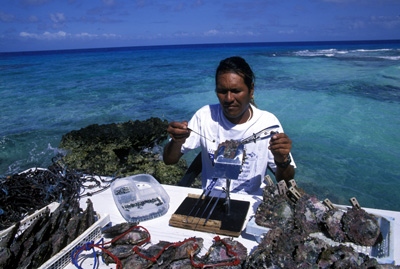 Tahiti Tourisme - Raymond Sahuquet
Tahiti Tourisme - Raymond SahuquetAn incision is made in the gonad (reproductive organ) to first implant graft tissue from another living oyster. This is a small piece of mantle, which will form a pouch around the nucleus to create the pearly coating, called nacre. Graft tissue is taken from the most colorful donor oysters to create pearls with the most beautiful colors.
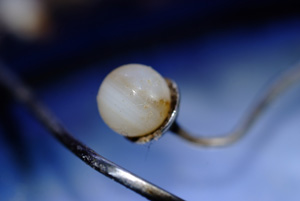 The Nucleus for implanting into the oyster.
Tahiti Tourisme - Raymond Sahuquet
The Nucleus for implanting into the oyster.
Tahiti Tourisme - Raymond SahuquetNext, the nucleus is implanted. This is a piece of 6mm to 8mm spherical shell, which is usually Mississippi River mussel (especially cultivated for this purpose) from Tennessee USA. Some farms now use mother of pearl from Pinctada oysters for their nuclei and produce more grade A pearls.
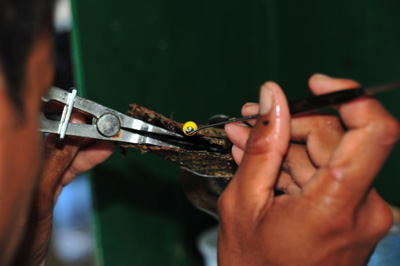 Implanting nucleus in pearl oyster.
Tahiti Tourisme - Gilles Diraimondo/AMV Voyages
Implanting nucleus in pearl oyster.
Tahiti Tourisme - Gilles Diraimondo/AMV VoyagesSo, how are pearls made? The oyster treats the shell implant as an invasive substance and secretes a black pigment (a type of calcium carbonate called aragonite) to protect its delicate reproductive system. This forms a surface of thousands of layers of lustrous nacre and is the magic that creates a treasured Tahitian black pearls.
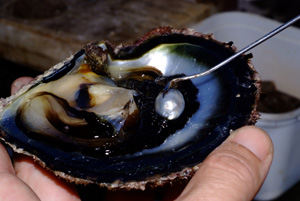 They oyster creates a surface of layers of lustrous nacre.
Tahiti Tourisme - Gilles Diaimondo/AWV Voyages
They oyster creates a surface of layers of lustrous nacre.
Tahiti Tourisme - Gilles Diaimondo/AWV VoyagesSkilled Technicians = The Best Cultured
Tahitian Pearls
This is a skilled operation and technicians must have a record of success to prove worthy of this important work. The expertise of the grafter is the most critical factor in producing a quality harvest. They are highly paid and booked years in advance. If the graft is mistakenly inserted between the coat and the shell, a half pearl will be formed. These sell for less, as they can only be used for rings and pendants. On family farms it is usual for family members to learn the trade and do the grafting.
How are Pearls Made: a Labor of Love
After grafting, the oysters are attached to long strings inside protective wire baskets. These are hung back on lines that straddle the lagoon, about 7 meters below the surface. These lines are tied to supports that are anchored down about 40 meters, on the bottom of the lagoon. It takes 1½ years for the beauty and luster of Tahitian black pearls to be perfected, so that it can be harvested.
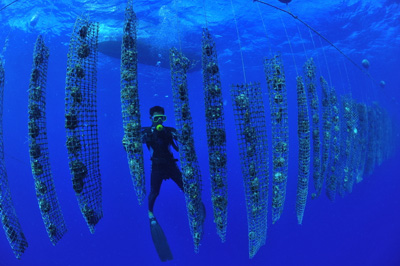 Tahiti Tourisme - Gilles Diraimondo/AMV Voyages
Tahiti Tourisme - Gilles Diraimondo/AMV VoyagesIf an oyster has produced a quality pearl, a second nucleus is positioned when the previous pearl is gently extracted. This nucleus is aproximately the size of the pearl that has been removed. Some oysters can create 4 consecutive cultured Tahitian pearls, each one larger than the last. But the quality of the pearling nacre declines with the increasing age of the oyster.
How are Pearls Made: Lagoon Temperature Consistency
Water temperature must be continually monitored. If a storm is likely, the strings of oysters are lowered deeper into the lagoon. In hot weather they are moved to a cooler place.
How are Pearls Made: Keeping the Shells Clean
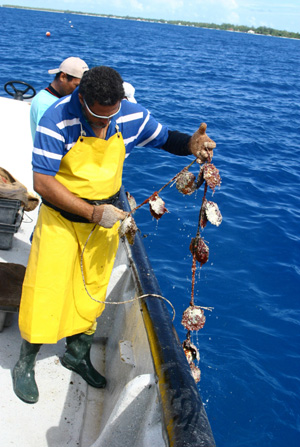
The oysters' shells must be kept clean so that they can properly filter their food, stay healthy and produce beautiful Tahitian black pearls. On some small farms the strings of oysters are hung from a platform in shallower water, every 3 months. This attracts the colorful lagoon fish who nibble the algae and other parasites that have attached themselves to the oyster shells. Another method is to manually remove unwanted organisms with a knife. Large farms use a high pressure hose to automate the process.
Now you know the the mystique surrounding, how are pearls made! It's a story of how man harnesses the combined efforts of animal and mineral to create prized 'jewels of the sea'. Find out how to recognize cultured Tahitian pearls.
Search the Site
Are you still looking for additional information? You can use the Google search box below to search the site.
Site Sponsors
Subscribe to receive free Bora Bora updates
Top Tours
Photo of the day
All of us at Bora Bora Island guide love to have fun, but we also have to keep the site up and running! That's why you'll see ads on this site. We may also earn commissions on some of the products on this site.
The income generated through these means helps ensure
Bora Bora Island Guide can devote the time to providing you
with all the free and fabulous information & resources you'll
find here. If you would like to support us, you can purchase our book full of over 100 pages of money saving tips or find out the best activities, resorts, dining and beaches in our Best of Bora Bora book or buy our 2018 Bora Bora calendar.
Want to learn more? Bora Bora Island Guide invites you to read our advertising disclosure.









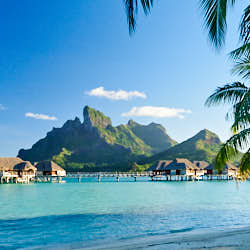



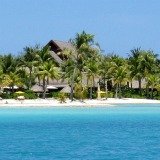



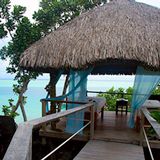
New! Comments
Have your say about what you just read! Leave me a comment in the box below.